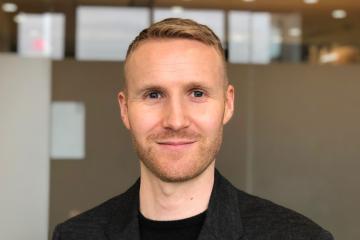
Affiliate Spotlight: Alicia Sasser Modestino on combating the opioid epidemic through rigorous research

Alicia Sasser Modestino is affiliate and an associate professor of public policy and urban affairs and economics at Northeastern University. Modestino also serves as the Director of Research at Northeastern University’s Dukakis Center for Urban and Regional Policy.
How did you arrive at the question motivating this research project, and why did you decide on this particular intervention?
The opioid crisis was at its height when we started thinking about the project. The sheer magnitude of the problem suggested that any research on this topic was going to be valuable. We decided to address part of the problem which was secondary users—individuals who obtain their opioid medication from family and friends, through a money transaction, or from improper disposal—who make up about 66 percent of individuals struggling with opioid addiction. This meant reducing the number of secondary users could prevent a major proportion of opioid-related deaths.
We ended up developing an intervention with two components. The first is providing information to people about the medication and how to properly dispose of it. It seems that prescription holders lack the information to make good choices about disposing unused opioid medications. We’ve learned that even though there are best practices around physicians informing people that they’re being prescribed an opioid, many people don’t even realize that they’re getting an opioid. The pharmacy is a potentially overlooked resource that can educate patients and be a point of contact to take that medication back. The second component is providing a financial incentive for individuals to properly dispose of their opioid prescriptions. We were curious to see whether this financial incentive resulted in more people bringing back their prescriptions.
How did the research partnership between you and the implementing partner, a local community health center, come about?
Initially, we considered both community health centers and commercial pharmacies like CVS or Walgreens, but these commercial pharmacies didn’t seem to have the financial incentive to partner. Community health centers ended up being the best candidates for this type of intervention, since they have very close ties with the populations they serve. They often know their patients for a long time and develop long-term relationships with them. That relationship makes it more likely that the patient will trust the pharmacist about the information they’re receiving and the ability to bring medication back safely with no questions asked.
The particular community health center we ended up partnering with had also done various interventions over the years around telemedicine and the opioid crisis. They have a track record of nimbly implementing new kinds of practices. Our partner’s willingness to experiment and enthusiasm made it a really easy partnership to develop.
Another factor we considered was a logistical one. The community health center serves a low-income, largely Latinx population. Due to barriers in communication and access to health care, as well as lower health literacy, this population was more likely to not be aware of how to dispose of medication safely and could benefit from the intervention. The city also has five different pharmacy locations, which gave us the ability to test out different combinations of our various interventions to see which were most effective.
What have been some of the more challenging aspects of carrying out this pilot?
It turns out that even with extensive planning, there are barriers and hurdles that are hard to foresee. The first hurdle was making a presentation to the Board of Pharmacy. The Board of Pharmacy does not formally regulate these kinds of interactions at the community health center, but the community health center relies on the Board of Pharmacy for other formal decisions about how they operate. There was a sense that our partner needed to ask permission from the Board of Pharmacy to be able to carry out the study.
The Board of Pharmacy’s concerns stemmed from a scandal around the handling of opioid medications in labs. For this study, they were concerned about pharmacists handling the medication in an unregulated way, the safe disposal of the medication, and the safety of the pharmacy itself if it became known that there was a large quantity of opioids being collected. In our proposal to the Board of Pharmacy, we made sure to highlight our strict protocol for the pharmacists to follow during an opioid buyback.
Due to manufacturing issues, there were also huge delays in getting the kiosks where the opioid prescriptions would be disposed of. However, we managed to use the six month delay to think about other aspects of the intervention that we had not developed as well. For example, we developed training materials to roll out to all of the pharmacists, drafted a tracking log to be updated daily, and put in place protocols for the transmission of data from our partner to Northeastern University.
Did you or your research assistants use any of J-PAL’s research resources to help you carry out this randomized evaluation? If so, how did those research resources help the team carry out this evaluation?
I sent my research assistant to Research Staff Training (RST) during which he learned about what a randomized controlled trial (RCT) is, how an RCT is designed, how to ensure the fidelity of an RCT, and how to even think securely transferring data. Whenever you’re dealing with health care interventions, there are many regulations around transferring data under the Health Insurance Portability and Accountability Act. He was really helpful in using what he had learned during RST to design the data transmission protocol for the project.
We also used J-PAL’s Short Term Research Management (STReaM) through which we had management assistance from J-PAL staff. The STReaM team helped us put in place the building blocks of how to run this randomized controlled trial. I had worked on other RCTs in the past, but not with a healthcare intervention or one that needed as much outside management. The team was really useful in helping think through the very minute details of our research protocol, and kept the project going on a weekly regular basis. During those weekly check-ins, we went over the very mundane details of the study, but it’s the mundane details that make your intervention run smoothly. The framework and infrastructure that the STReaM team provided helped us deal with future challenges down the road like COVID-19 interrupting your entire research project.
What are some next steps for this study?
Around 10 percent of people that were notified are bringing back their medication, while we thought it would be much higher like 25 or 30 percent. We hope to resume our qualitative work to see if modifications to the intervention would increase the rate of buybacks. We’re currently discussing involving the physician or prescriber to see if it carries more weight to hear the information from your doctor. We’re also considering combining the financial incentive with the text message reminder to see if the combination makes the information more salient.
What is your advice for researchers or practitioners who are interested in pursuing a research partnership like the one you have with your implementing partner?
I really can’t imagine doing this without a good partnership. For this study, we receive a weekly update from our partner about how the intervention is going and how many people are being reached. This information allows us to troubleshoot problems earlier on before they become a bigger issue or a question mark in your dataset. Our partner also helps interpret the data and understand the mechanisms behind the numbers.
Every time we get an update, we also get the stories behind the buybacks that happened. We learned some really interesting things through these stories. For example, one woman brought back medication that had been prescribed to her adult daughter who was misusing the medication. This woman used the program as the excuse to get the medication out of the house. We hadn’t previously thought about the caregiver as being someone who would use this program. We also had two patients who refused to even take the medication once they were notified that it was an opioid. It’s evident that there’s a lot more on the education front that could be done even at the pharmacy level. It’s possible that people aren’t making very conscious decisions to receive an opioid prescription.
Having a strong relationship with your partner can provide an important qualitative component to your study. Even if you’re not doing a mixed methods study, these stories can help you understand some of the mechanisms behind the results that you’re seeing and help future decision-makers shape effective policies.
Related Content

Affiliate spotlight: Will Dobbie on conducting randomized evaluations to reduce inequalities in the United States
Affiliate spotlight: William Evans on holistic approaches to reducing poverty in the United States

